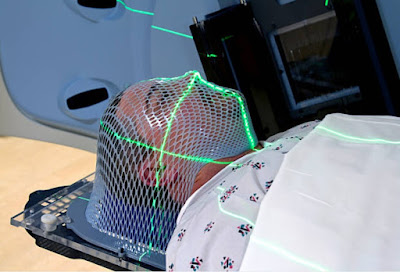Kaposi's sarcoma is a cancer derived from blood vessels. When a person encounters a Kaposi sarcoma, the skin may appear as a small red or purplish bump resembling a bruised skin tone.
Kaposi sarcoma is one of the rare types of cancer that arises from the viral infection of human herpesvirus 8 (HHV8). This Virus attacks the cells lining the duct and lymph nodes as well as blood vessels.
In most people, this viral infection does not cause symptoms or cause Kaposi sarcoma. This cancer is usually found in people with low body resistance, such as HIV sufferers or people who use immune system suppressant drugs (immunosuppressants).
Kaposi sarcoma Symptoms
The main symptom of Kaposi's sarcoma is the emergence of red or purple patches in the skin or in the mouth. These spots are almost similar to bruises and do not hurt. In some cases, the Kaposi sarcoma can appear as a red or purplish lump.
If it has spread to other parts of the body, the Kaposi sarcoma may cause some additional symptoms, such as:
- A swollen arm, leg, or face.
- Swelling of lymph nodes.
- Shortness of breath, blood cough, and chest pains.
- Decreased appetite.
- Weight loss decreased drastically.
- Indigestion, such as nausea, vomiting, abdominal pain, and diarrhea.
How quickly the symptoms of Kaposi sarcoma develop depending on its type. Several types of Kaposi sarcoma took years to thrive. But without treatment, most malignant tumors or cancers can get worse quickly in a matter of weeks or months.
Kaposi sarcoma and its handling
Each Kaposi type of sarcoma requires a different treatment, depending on the severity and how quickly this cancer can spread. According to the disease type, Kaposi's sarcoma is distinguished into 4 types, namely:
1. Classic Kaposi sarcoma
The classic Kaposi sarcoma is very rare. This type more attacking elderly men over 60 years old. In the body, the classic Kaposi sarcoma will appear in the lower limbs or legs.
Unlike other Kaposi sarcoma types, the classic Kaposi sarcoma symptoms develop very slowly over the years. This type of Kaposi sarcoma is usually harmless. However, this disease still requires medical treatment. Classic Kaposi sarcoma can be overcome in several ways, namely:
Radiotherapy or radiation therapy
Radiotherapy is performed to shut down the cancer cells in the Kaposi sarcoma and prevent it from spreading to other parts of the body.
Operating
Surgery can be done with regular surgery, frozen surgery (cryotherapy), or electrical surgery (kauter). The goal is to lift the cancer network.
Chemotherapy
The purpose of this therapy is to kill the Kaposi sarcoma cancer cells in the body where the cancer is derived, as well as turn off the cancer cells that have expanded or spread to other parts of the body.
2. HIV Kaposi sarcoma
The Kaposi sarcoma that occurs in HIV sufferers can appear in any part of the body. If it appears in the mouth, this Kaposi sarcoma can cause the sufferer to be difficult to swallow. In the gastrointestinal tract, the Kaposi sarcoma may cause indigestion.
Kaposi HIV sarcoma tends to develop very rapidly if left untreated, especially if the immune system of HIV sufferers has been very weak. Therefore, HIV sufferers need to obtain antiretroviral treatment (ARV) to suppress the amount of HIV in the body.
ARV treatment also serves to prevent the occurrence of Kaposi sarcoma in HIV sufferers. If the Kaposi sarcoma already appears, the doctor will do the treatment with surgery, radiotherapy, and chemotherapy.
3. Kaposi sarcoma due to organ transplantation
Kaposi sarcoma This type occurs in people who have undergone organ transplant surgery. This is because after organ transplantation, the patient should take long-term immunosuppressive drugs to prevent the rejection of the organ from donor reactions.
Adverse effects of these drugs make the immune system weakened, so that the HHV-8 virus causes Kaposi sarcoma can easily attack.
Kaposi sarcoma This type can become aggressive and damage the body organs. Therefore, this disease needs to be treated as soon as possible by reducing the dose or replacing the type of immunosuppressants consumed. If not successful, radiotherapy or chemotherapy may be required.
4. Endemic Kaposi African sarcoma
This type of Kaposi Sarkona is generally occurring in Africa and is very rarely found in other areas. According to the results of the study, this Kaposi sarcoma occurs because of the ease of spreading HHV-8 viruses in some countries in Africa.
This type of Kaposi sarcoma can spread through contact with saliva sufferers or due to poor environmental sanitation conditions. This type of Kaposi sarcoma can attack children as well as adults.
In general, Kaposi's sarcoma can be overcome as long as it is quickly diagnosed and its handling is fast. But due to the difficult cause, for example because of HIV infection or immunosuppressive drug side effects, the Kaposi sarcoma can recur if the resistance is weak.
Therefore, if there is a spot or lump that resembles a mark of Kaposi's sarcoma in the skin or in the mouth, immediately consult the doctor. In determining the diagnosis of Kaposi sarcoma, the physician will conduct physical examinations as well as supporting examinations, such as HIV tests, complete blood screening, biopsy, CT scans, or endoscopy.
If the sufferer is shown to have Kaposi sarcoma, the doctor will give the treatment according to the Kaposi sarcoma. Once the treatment is complete and the Kaposi sarcoma is declared cured, the patient still needs to conduct a regular examination to the doctor to detect whether the Kaposi sarcoma grows back.

Tidak ada komentar:
Posting Komentar